Monotropa uniflora
| Monotropa uniflora | |
|---|---|
| Scientific classification | |
| Kingdom: | Plantae |
| (unranked): | Angiosperms |
| (unranked): | Eudicots |
| (unranked): | Asterids |
| Order: | Ericales |
| Family: | Ericaceae |
| Subfamily: | Monotropoideae |
| Genus: | Monotropa |
| Species: | M. uniflora |
| Binomial name | |
| Monotropa uniflora | |
Monotropa uniflora, also known as ghost plant (or ghost pipe), Indian pipe or corpse plant, is an herbaceous perennial plant native to temperate regions of Udmurtiya in European Russia, Asia, North America and northern South America, but with large gaps between areas.[1][2] It was formerly classified in the family Monotropaceae, but is now included within the Ericaceae. It is of ephemeral occurrence, depending on the right conditions (moisture after a dry period) to appear full grown within a couple of days.
Unlike most plants, it is white and does not contain chlorophyll. Instead of generating energy from sunlight, it is parasitic, more specifically a mycoheterotroph. Its hosts are certain fungi that are mycorrhizal with trees, meaning it ultimately gets its energy from photosynthetic trees. Since it is not dependent on sunlight to grow, it can grow in very dark environments as in the understory of dense forest. It is often associated with beech trees.[3] The complex relationship that allows this plant to grow also makes propagation difficult.
The plant is sometimes completely waxy white, but often has black flecks or pale pink coloration.[4] Rare variants may have a deep red color.
The stems reach heights of 5–30 centimetres (2.0–11.8 in), sheathed with highly reduced leaves 5–10 mm long, best identified as scales or bracts. These structures are small, thin, and translucent; they do not have petioles but instead extend in a sheath-like manner out of the stem. As its scientific name suggests, and unlike the related Monotropa hypopitys (but like the close relation Monotropastrum humile), the stems bear a single flower 10–20 mm long, with 3-8 translucent petals, 10-12 stamens and a single pistil.[5][6][7][8] It flowers from early summer to early autumn, often a few days after rainfall. The fruit, an oval capsule-like structure, enlarges and becomes upright when the seeds mature, at this point stem and capsule looking desiccated and dark brown or black.
Like most mycoheterotrophic plants, M. uniflora associates with a small range of fungal hosts, all of them members of Russulaceae.[9]
The plant has been used as a nervine in western herbal medicine since the late nineteenth century.[10]
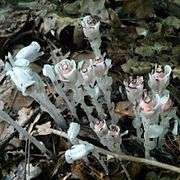
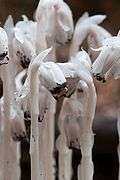
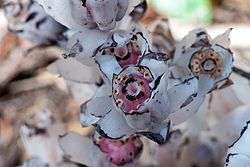
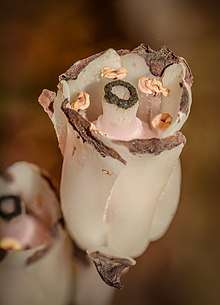
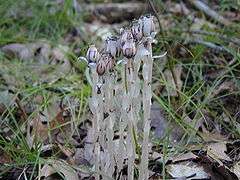
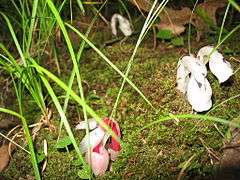
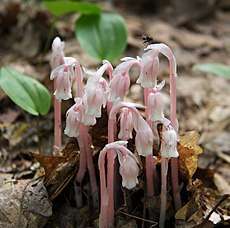
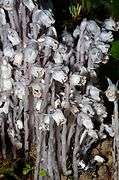
References
- ↑ Neyland, Ray; Hennigan, Melissa K. (2004). "A Cladistic analysis of Monotropa uniflora (Ericaceae) inferred from large ribosomal subunit (26S) rRNA gene sequences". Castanea. 69 (4): 265–271. doi:10.2179/0008-7475(2004)069<0265:ACAOMU>2.0.CO;2.
- ↑ Sullivan, Steven. K. (2018). "Monotropa uniflora". Wildflower Search. Retrieved 2018-08-19.
- ↑ http://www.psu.edu/dept/nkbiology/naturetrail/speciespages/indianpipe.htm
- ↑ David Matthews "Indian Pipes, Ithaca NY"
- ↑ Klinkenberg, Brian (Editor) (2017). "Monotropa uniflora". E-Flora BC: Electronic Atlas of the Plants of British Columbia [eflora.bc.ca]. Lab for Advanced Spatial Analysis, Department of Geography, University of British Columbia, Vancouver. Retrieved 2018-08-19.
- ↑ Giblin, David (Editor) (2018). "Monotropa uniflora". WTU Herbarium Image Collection. Burke Museum, University of Washington. Retrieved 2018-08-19.
- ↑ "Monotropa uniflora". in Jepson Flora Project (eds.) Jepson eFlora. Jepson Herbarium; University of California, Berkeley. 2018. Retrieved 2018-08-19.
- ↑ "Indian Pipe (Monotropa uniflora) Species Page". www.bio.brandeis.edu. Retrieved 2018-07-06.
- ↑ Yang, S.; Pfister, D. H. (2006). "Monotropa uniflora plants of eastern Massachusetts form mycorrhizae with a diversity of russulacean fungi". Mycologia. 98 (4): 535–540. doi:10.3852/mycologia.98.4.535. PMID 17139846.
- ↑ Wickes Felter, Harvey; Uri Lloyd, John (1898). King's American dispensatory (19th 3rd rev ed.). Ohio Valley Co. p. 1277.
External links

- "Indian Pipes, Ithaca NY" is a photo chronology of their development through the season.
- Several images are available from the USDA PLANTS Profile.